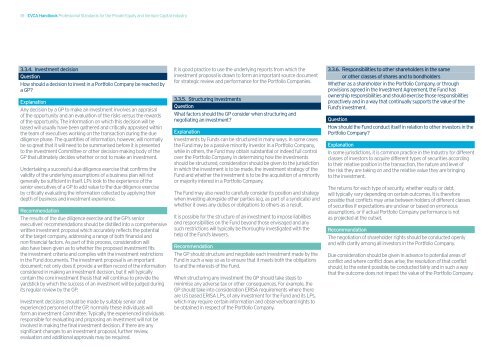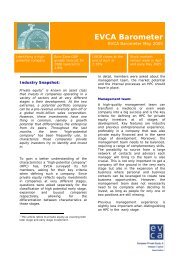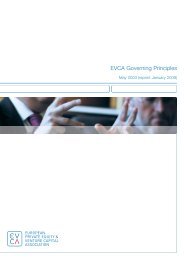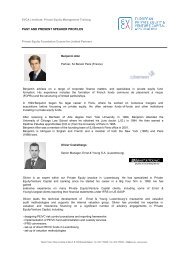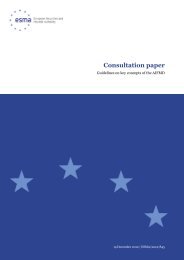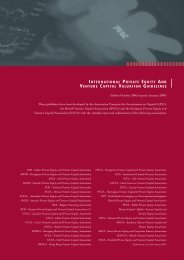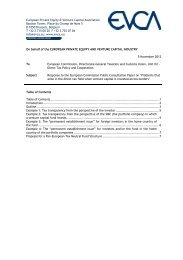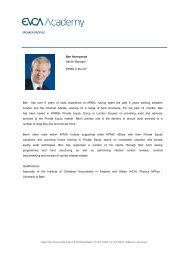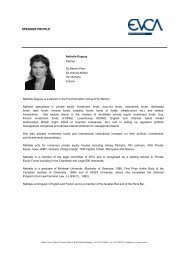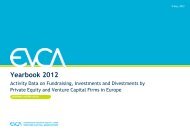EVCA Handbook Professional Standards for the Private Equity and ...
EVCA Handbook Professional Standards for the Private Equity and ...
EVCA Handbook Professional Standards for the Private Equity and ...
- No tags were found...
Create successful ePaper yourself
Turn your PDF publications into a flip-book with our unique Google optimized e-Paper software.
18 <strong>EVCA</strong> <strong>H<strong>and</strong>book</strong> <strong>Professional</strong> <strong>St<strong>and</strong>ards</strong> <strong>for</strong> <strong>the</strong> <strong>Private</strong> <strong>Equity</strong> <strong>and</strong> Venture Capital Industry3.3.4. Investment decisionQuestionHow should a decision to invest in a Portfolio Company be reached bya GP?ExplanationAny decision by a GP to make an investment involves an appraisalof <strong>the</strong> opportunity <strong>and</strong> an evaluation of <strong>the</strong> risks versus <strong>the</strong> rewardsof <strong>the</strong> opportunity. The in<strong>for</strong>mation on which this decision will bebased will usually have been ga<strong>the</strong>red <strong>and</strong> critically appraised within<strong>the</strong> team of executives working on <strong>the</strong> transaction during <strong>the</strong> duediligence phase. The quantities of in<strong>for</strong>mation, however, will normallybe so great that it will need to be summarised be<strong>for</strong>e it is presentedto <strong>the</strong> Investment Committee or o<strong>the</strong>r decision-making body of <strong>the</strong>GP that ultimately decides whe<strong>the</strong>r or not to make an investment.Undertaking a successful due diligence exercise that confirms <strong>the</strong>validity of <strong>the</strong> underlying assumptions of a business plan will notgenerally be sufficient in itself. LPs look to <strong>the</strong> experience of <strong>the</strong>senior executives of a GP to add value to <strong>the</strong> due diligence exerciseby critically evaluating <strong>the</strong> in<strong>for</strong>mation collected by applying <strong>the</strong>irdepth of business <strong>and</strong> investment experience.RecommendationThe results of <strong>the</strong> due diligence exercise <strong>and</strong> <strong>the</strong> GP’s seniorexecutives’ recommendations should be distilled into a comprehensivewritten investment proposal which accurately reflects <strong>the</strong> potentialof <strong>the</strong> target company, addressing a range of both financial <strong>and</strong>non-financial factors. As part of this process, consideration willalso have been given as to whe<strong>the</strong>r <strong>the</strong> proposed investment fits<strong>the</strong> investment criteria <strong>and</strong> complies with <strong>the</strong> investment restrictionsin <strong>the</strong> Fund documents. The investment proposal is an importantdocument; not only does it provide a written record of <strong>the</strong> in<strong>for</strong>mationconsidered in making an investment decision, but it will typicallycontain <strong>the</strong> core investment <strong>the</strong>sis that will continue to provide <strong>the</strong>yardstick by which <strong>the</strong> success of an investment will be judged duringits regular review by <strong>the</strong> GP.Investment decisions should be made by suitably senior <strong>and</strong>experienced personnel of <strong>the</strong> GP; normally <strong>the</strong>se individuals will<strong>for</strong>m an Investment Committee. Typically, <strong>the</strong> experienced individualsresponsible <strong>for</strong> evaluating <strong>and</strong> proposing an investment will not beinvolved in making <strong>the</strong> final investment decision. If <strong>the</strong>re are anysignificant changes to an investment proposal, fur<strong>the</strong>r review,evaluation <strong>and</strong> additional approvals may be required.It is good practice to use <strong>the</strong> underlying reports from which <strong>the</strong>investment proposal is drawn to <strong>for</strong>m an important source document<strong>for</strong> strategic review <strong>and</strong> per<strong>for</strong>mance <strong>for</strong> <strong>the</strong> Portfolio Companies.3.3.5. Structuring investmentsQuestionWhat factors should <strong>the</strong> GP consider when structuring <strong>and</strong>negotiating an investment?ExplanationInvestments by Funds can be structured in many ways. In some cases<strong>the</strong> Fund may be a passive minority investor in a Portfolio Company,while in o<strong>the</strong>rs, <strong>the</strong> Fund may obtain substantial or indeed full controlover <strong>the</strong> Portfolio Company. In determining how <strong>the</strong> investmentsshould be structured, consideration should be given to <strong>the</strong> jurisdictionin which <strong>the</strong> investment is to be made, <strong>the</strong> investment strategy of <strong>the</strong>Fund <strong>and</strong> whe<strong>the</strong>r <strong>the</strong> investment is to be <strong>the</strong> acquisition of a minorityor majority interest in a Portfolio Company.The Fund may also need to carefully consider its position <strong>and</strong> strategywhen investing alongside o<strong>the</strong>r parties (e.g. as part of a syndicate) <strong>and</strong>whe<strong>the</strong>r it owes any duties or obligations to o<strong>the</strong>rs as a result.It is possible <strong>for</strong> <strong>the</strong> structure of an investment to impose liabilities<strong>and</strong> responsibilities on <strong>the</strong> Fund beyond those envisaged <strong>and</strong> anysuch restrictions will typically be thoroughly investigated with <strong>the</strong>help of <strong>the</strong> Fund’s lawyers.RecommendationThe GP should structure <strong>and</strong> negotiate each investment made by <strong>the</strong>Fund in such a way so as to ensure that it meets both <strong>the</strong> obligationsto <strong>and</strong> <strong>the</strong> interests of <strong>the</strong> Fund.When structuring any investment <strong>the</strong> GP should take steps tominimise any adverse tax or o<strong>the</strong>r consequences. For example, <strong>the</strong>GP should take into consideration ERISA requirements where <strong>the</strong>reare US based ERISA LPs, of any investment <strong>for</strong> <strong>the</strong> Fund <strong>and</strong> its LPs,which may require certain in<strong>for</strong>mation <strong>and</strong> observer/board rights tobe obtained in respect of <strong>the</strong> Portfolio Company.3.3.6. Responsibilities to o<strong>the</strong>r shareholders in <strong>the</strong> sameor o<strong>the</strong>r classes of shares <strong>and</strong> to bondholdersWhe<strong>the</strong>r as a shareholder in <strong>the</strong> Portfolio Company, or throughprovisions agreed in <strong>the</strong> Investment Agreement, <strong>the</strong> Fund hasownership responsibilities <strong>and</strong> should exercise those responsibilitiesproactively <strong>and</strong> in a way that continually supports <strong>the</strong> value of <strong>the</strong>Fund’s investment.QuestionHow should <strong>the</strong> Fund conduct itself in relation to o<strong>the</strong>r investors in <strong>the</strong>Portfolio Company?ExplanationIn some jurisdictions, it is common practice in <strong>the</strong> Industry <strong>for</strong> differentclasses of investors to acquire different types of securities accordingto <strong>the</strong>ir relative position in <strong>the</strong> transaction, <strong>the</strong> nature <strong>and</strong> level of<strong>the</strong> risk <strong>the</strong>y are taking on <strong>and</strong> <strong>the</strong> relative value <strong>the</strong>y are bringingto <strong>the</strong> investment.The returns <strong>for</strong> each type of security, whe<strong>the</strong>r equity or debt,will typically vary depending on certain outcomes. It is <strong>the</strong>re<strong>for</strong>epossible that conflicts may arise between holders of different classesof securities if expectations are unclear or based on erroneousassumptions, or if actual Portfolio Company per<strong>for</strong>mance is notas projected at <strong>the</strong> outset.RecommendationThe negotiation of shareholder rights should be conducted openly<strong>and</strong> with clarity among all investors in <strong>the</strong> Portfolio Company.Due consideration should be given in advance to potential areas ofconflict <strong>and</strong> where conflict does arise, <strong>the</strong> resolution of that conflictshould, to <strong>the</strong> extent possible, be conducted fairly <strong>and</strong> in such a waythat <strong>the</strong> outcome does not impact <strong>the</strong> value of <strong>the</strong> Portfolio Company.


